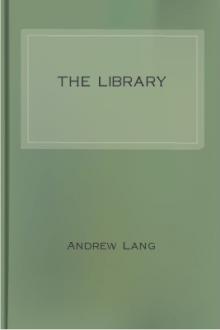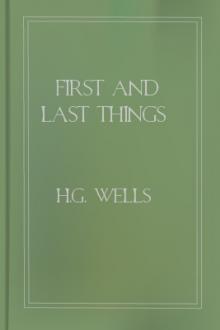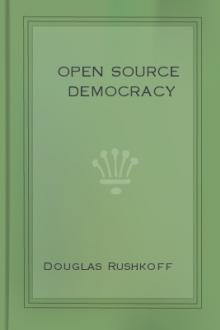The Library by Andrew Lang (i have read the book a hundred times txt) 📕

- Author: Andrew Lang
- Performer: -
Book online «The Library by Andrew Lang (i have read the book a hundred times txt) 📕». Author Andrew Lang
Even in his last hours he was seeking for new processes. What we want is to get nearest to the artist himself with the least amount of interpretation or intermediation on the part of the engraver. Is engraving on copper to be reproduced, we want a facsimile if possible, and not a rendering into something which is supposed to be the orthodox utterance of wood-engraving. Take, for example, the copy of Schiavonetti’s engraving of Blake’s Death’s Door in “Scribner’s Magazine” for June 1880, or the cut from the same source at page 131 of this book. These are faithful line for line transcriptions, as far as wood can give them, of the original copperplates; and, this being the case, it is not to be wondered at that the public, who, for a few pence can have practical facsimiles of Blake, of Cruikshank, or of Whistler, are loud in their appreciation of the “new American School.” Nor are its successes confined to reproduction in facsimile. Those who look at the exquisite illustrations, in the same periodical, to the “Tile Club at Play,” to Roe’s “Success with Small Fruits,” and Harris’s “Insects Injurious to Vegetation,”—to say nothing of the selected specimens in the recently issued “Portfolios”—will see that the latest comers can hold their own on all fields with any school that has gone before. {15}
Besides copperplate and wood, there are many processes which have been and are still employed for book-illustrations, although the brief limits of this chapter make any account of them impossible.
Lithography was at one time very popular, and, in books like Roberts’s “Holy Land,” exceedingly effective. The “Etching Club”
issued a number of books circa 1841-52; and most of the work of “Phiz” and Cruikshank was done with the needle. It is probable that, as we have already seen, the impetus given to modern etching by Messrs. Hamerton, Seymour Haden, and Whistler, will lead to a specific revival of etching as a means of book-illustration.
Already beautiful etchings have for some time appeared in “L’Art,”
the “Portfolio,” and the “Etcher;” and at least one book of poems has been entirely illustrated in this way,—the poems of Mr. W. Bell Scott. For reproducing old engravings, maps, drawings, and the like, it is not too much to say that we shall never get anything much closer than the facsimiles of M. Amand-Durand and the Typographic Etching and Autotype Companies. But further improvements will probably have to be made before these can compete commercially with wood-engraving as practised by the “new American School.”
“Of making many books,” ‘twais said,
“There is no end;” and who thereon
The ever-running ink doth shed
But probes the words of Solomon:
Wherefore we now, for colophon,
From London’s city drear and dark,
In the year Eighteen Eight-One,
Reprint them at the press of Clark.
A. D.
Footnotes:
{1} This is the technical name for people who “illustrate” books with engravings from other works. The practice became popular when Granger published his “Biographical History of England.”
{2} Mr. William Blades, in his “Enemies of Books” (Trubner, 1880), decries glass-doors,— “the absence of ventilation will assist the formation of mould.” But M. Rouveyre bids us open the doors on sunny days, that the air may be renewed, and, close them in the evening hours, lest moths should enter and lay their eggs among the treasures. And, with all deference to Mr. Blades, glass-doors do seem to be useful in excluding dust.
{3} “Send him back carefully, for you can if you like, that all unharmed he may return to his own place.”
{4} No wonder the books are scarce, if they are being hacked to pieces by Grangerites.
{5} These lines appeared in “Notes and Queries,” Jan. 8, 1881.
{6} In the Golden Ass of Apuleius, which Polia should not have read.
{7} M. Arsene Houssaye seems to think he has found them; marked on the fly-leaves with an impression, in wax, of a seal engraved with the head of Epicurus.
{8} This chapter was written by Austin Dobson.—DP
{9} The recent Winter Exhibition of the Old Masters (1881) contained a fine display of Flaxman’s drawings, a large number of which belonged to Mr. F. T. Palgrave.
{10} By Mr. Cosmo Monkhouse.
{11} These words were written before the “Art Journal” had published its programme for 1881. From this it appears that the present editor fully recognises the necessity for calling in the assistance of the needle.
{12} The example, here copied on the wood by M. Lacour, is a very successful reproduction of Clennell’s style.
{13} He also illustrated the “Memoirs of Joseph Grimaldi.” But this was simply “edited” by “Boz.”
{14} The reader will observe that this volume is indebted to Mr.
Crane for its beautiful frontispiece.
{15} Since this paragraph was first written an interesting paper on the illustrations in “Scribner,” from the pen of Mr. J. Comyns Carr, has appeared in “L’Art.”
End of The Project Gutenberg Etext of The Library, by Andrew Lang





Comments (0)